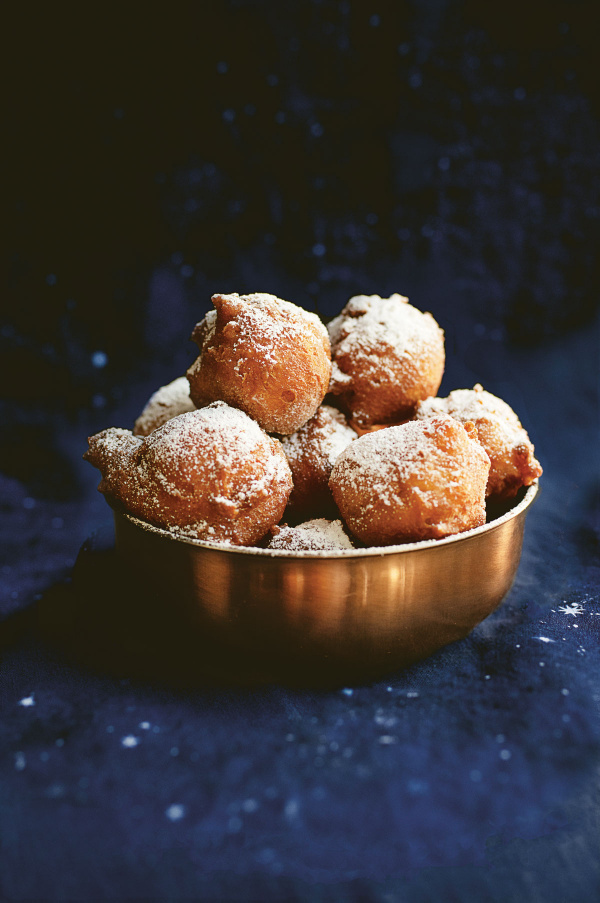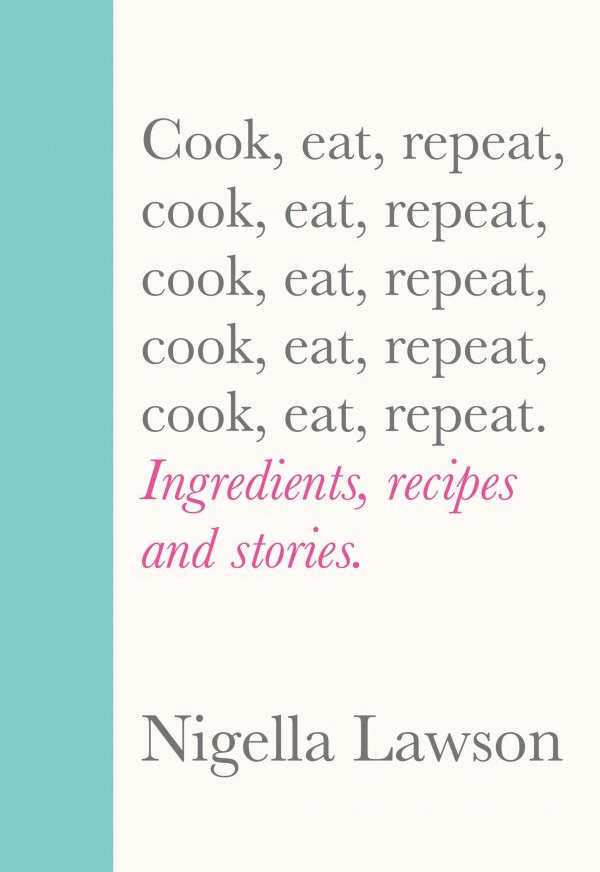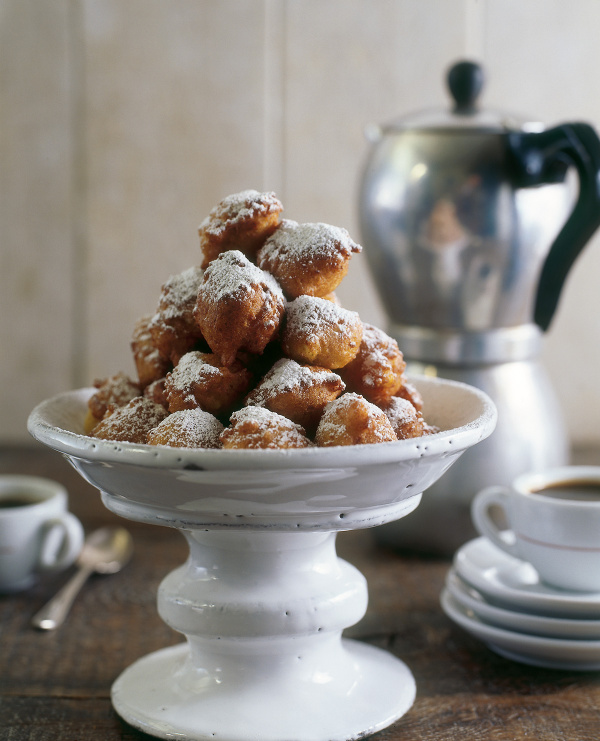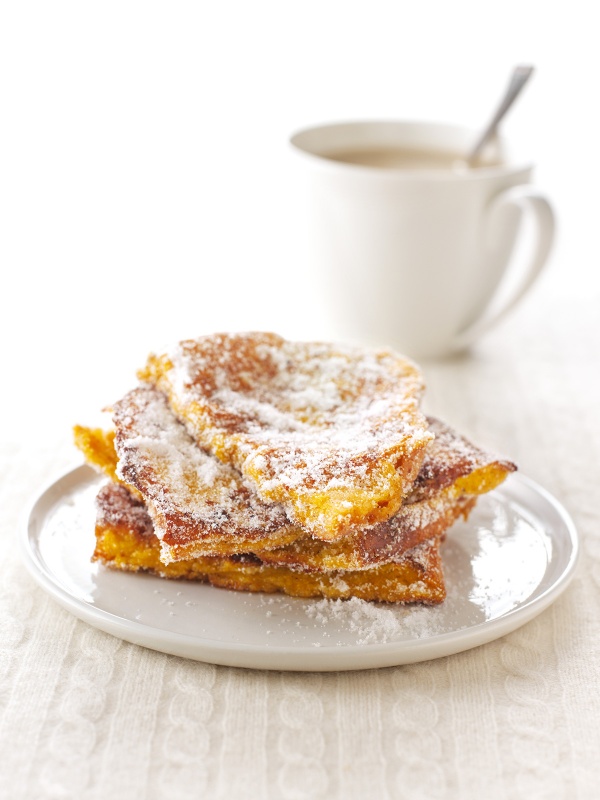New Year Doughnuts - Oliebollen
by Nigella. Featured in COOK EAT REPEATIntroduction
This recipe didn’t find its way into my Amsterdam Christmas Special since it had already appeared in the CER Christmas show, but you can’t set foot in the Netherlands in the festive period without encountering these Dutch doughnuts, even though it’s on New Year’s Eve that they are most traditionally eaten; indeed, it’s said that the whole of the kingdom smells of frying and icing sugar on New Year’s Eve.
I make my Oliebollen slightly smaller than is customary, and without the dried fruit that’s traditionally added, since that is the way I like them. By all means, though, add about 2 tablespoons each of raisins and currants which you’ve soaked overnight in 2 tablespoons of rum or orange juice (folding the plumped-up fruit into the dough once it’s mixed up and ready to prove) if you should so prefer. And while they are meant to be ball-shaped, I love it when the dough drips a little as they go into the pan, making super-crunchy spikes in the hot oil.
For US cup measures, use the toggle at the top of the ingredients list.
This recipe didn’t find its way into my Amsterdam Christmas Special since it had already appeared in the CER Christmas show, but you can’t set foot in the Netherlands in the festive period without encountering these Dutch doughnuts, even though it’s on New Year’s Eve that they are most traditionally eaten; indeed, it’s said that the whole of the kingdom smells of frying and icing sugar on New Year’s Eve.
I make my Oliebollen slightly smaller than is customary, and without the dried fruit that’s traditionally added, since that is the way I like them. By all means, though, add about 2 tablespoons each of raisins and currants which you’ve soaked overnight in 2 tablespoons of rum or orange juice (folding the plumped-up fruit into the dough once it’s mixed up and ready to prove) if you should so prefer. And while they are meant to be ball-shaped, I love it when the dough drips a little as they go into the pan, making super-crunchy spikes in the hot oil.
For US cup measures, use the toggle at the top of the ingredients list.

Share or save this
Ingredients
Makes: approx. 30
- 250 grams plain flour
- A pinch of salt
- 2 x 15ml tablespoons (25g) caster sugar
- 2½ teaspoons (7g) or 1 x 7g/¼oz sachet fast-action dried yeast
- 250 millilitres full fat milk
- An exuberant grating of nutmeg
- 1 lemon
- 1 teaspoon vanilla extract
- 2 x 15ml tablespoons (30g) soft unsalted butter
- 1 large egg (at room temperature)
- sunflower oil or frying; depending on what you’re frying in, approx. 4 litres/quarts in a deep-fat fryer, and approx. 1.5 litres/quarts in a 22cm/9in diameter pan
- icing sugar (for dusting)
- 2 cups all-purpose flour
- A pinch of salt
- 2 tablespoons (25g) superfine sugar
- 2½ teaspoons (7g) or 1 x 7g/¼oz sachet fast-action dried yeast
- 1 cup whole milk
- An exuberant grating of nutmeg
- 1 lemon
- 1 teaspoon vanilla extract
- 2 tablespoons (30g) soft unsalted butter
- 1 large egg (at room temperature)
- vegetable oil or frying; depending on what you’re frying in, approx. 4 litres/quarts in a deep-fat fryer, and approx. 1.5 litres/quarts in a 22cm/9in diameter pan
- confectioners' sugar (for dusting)
Method
- Mix the flour, salt, sugar and yeast in a large bowl.
- Pour the milk into a saucepan or, if you have a microwave, a measuring jug. Either way, finely grate in a generous amount of nutmeg, followed by the zest of the lemon, add the vanilla and butter and heat until lukewarm; I just give the milk 45 seconds in the microwave at top whack, which for me means 900W. And it doesn’t matter, by the way, if the butter doesn’t melt entirely.
- If you’ve heated the milk in a pan, pour it into a jug. Crack the egg into the jug, quickly whisk it in, then pour the lukewarm, lemon-scented, nutmeggy, buttery and eggy milk into the dry ingredients, beating vigorously with a wooden spoon or a little hand whisk until you have a smooth dough. Well, I say ‘dough’ since you’re making doughnuts with it, but actually it has more the consistency of thick cake batter.
- Cover the bowl with food wrap or a slightly dampened tea towel, and leave in a warm place for about 1¼ hours, until the dough has puffed up voluminously and the surface is a mass of large bubbles. When I was young, the airing cupboard was always the place where dough would be left to prove, but times change, and I put the bowl on a shelf up above all the computer bits and pieces and their flashing lights, aka Mission Control. A warm and steamy kitchen will do fine, though. (And if you wanted to make the dough in advance, you could instead stash the bowl, covered with food wrap, in the fridge to rise slowly overnight or for up to 24 hours, in which case, let it come to room temperature before proceeding to step 5.
- Using, for ease, a bendy spatula, scrape down the sides, which will deflate the dough. It will start bubbling up again as you wait for the oil to heat.
- If you’re going to make your oliebollen in an electric deep-fat fryer — which is very much easier — pour in sunflower oil until it reaches the minimum mark. Otherwise, use a heavy-based saucepan at least 12cm/5in deep and no less than 22cm/9in diameter — pour in enough oil to come up about 3½cm/1½in. Heat the oil to 180°C/350°F. Don’t leave the oil unattended while it heats up, but you can potter about nearby, getting yourself a rounded metal tablespoon measure and a teaspoon to shape the doughnuts (though you could just use a couple of dessert spoons) and some tongs to turn them as they fry and to retrieve them once they’re cooked. You’ll also need to line a couple of large plates with kitchen paper (replacing as necessary) and fill a small bowl with cold oil for you to dip your spoons in while cooking.
- Once the oil is at 180°C/350°F (and if you’re frying them in a saucepan, you really do need to use a digital or jam thermometer) carefully dip your rounded tablespoon measure and teaspoon (or pair of dessert spoons) into the cold oil, then scoop up a tablespoon of dough, using the teaspoon to help mould it and then release it gently into the hot oil, then do the same to make a second one and fry them about 2½–3 minutes a side, so that they are a deep golden brown all over, and the dough is cooked all the way through. And the only way to find out is to eat these first two, allowing them to cool for a few minutes and dusting each with icing sugar before you bite in.
- Once you’re happy with the timings, repeat the process (without necessarily eating them all) to fill your pan without overcrowding it; I don’t like to fry more than four or five at the same time.
- Transfer them as they’re ready to the paper-lined plates to blot the excess oil. Leave them on the kitchen paper for 3–5 minutes; the icing sugar will melt if it’s sprinkled on them when they’re piping hot. Then arrange on a few plates, and dust generously with icing sugar. Eat immediately.
- Mix the flour, salt, sugar and yeast in a large bowl.
- Pour the milk into a saucepan or, if you have a microwave, a measuring jug. Either way, finely grate in a generous amount of nutmeg, followed by the zest of the lemon, add the vanilla and butter and heat until lukewarm; I just give the milk 45 seconds in the microwave at top whack, which for me means 900W. And it doesn’t matter, by the way, if the butter doesn’t melt entirely.
- If you’ve heated the milk in a pan, pour it into a jug. Crack the egg into the jug, quickly whisk it in, then pour the lukewarm, lemon-scented, nutmeggy, buttery and eggy milk into the dry ingredients, beating vigorously with a wooden spoon or a little hand whisk until you have a smooth dough. Well, I say ‘dough’ since you’re making doughnuts with it, but actually it has more the consistency of thick cake batter.
- Cover the bowl with food wrap or a slightly dampened tea towel, and leave in a warm place for about 1¼ hours, until the dough has puffed up voluminously and the surface is a mass of large bubbles. When I was young, the airing cupboard was always the place where dough would be left to prove, but times change, and I put the bowl on a shelf up above all the computer bits and pieces and their flashing lights, aka Mission Control. A warm and steamy kitchen will do fine, though. (And if you wanted to make the dough in advance, you could instead stash the bowl, covered with food wrap, in the fridge to rise slowly overnight or for up to 24 hours, in which case, let it come to room temperature before proceeding to step 5.
- Using, for ease, a bendy spatula, scrape down the sides, which will deflate the dough. It will start bubbling up again as you wait for the oil to heat.
- If you’re going to make your oliebollen in an electric deep-fat fryer — which is very much easier — pour in vegetable oil until it reaches the minimum mark. Otherwise, use a heavy-based saucepan at least 12cm/5in deep and no less than 22cm/9in diameter — pour in enough oil to come up about 3½cm/1½in. Heat the oil to 180°C/350°F. Don’t leave the oil unattended while it heats up, but you can potter about nearby, getting yourself a rounded metal tablespoon measure and a teaspoon to shape the doughnuts (though you could just use a couple of dessert spoons) and some tongs to turn them as they fry and to retrieve them once they’re cooked. You’ll also need to line a couple of large plates with kitchen paper (replacing as necessary) and fill a small bowl with cold oil for you to dip your spoons in while cooking.
- Once the oil is at 180°C/350°F (and if you’re frying them in a saucepan, you really do need to use a digital or jam thermometer) carefully dip your rounded tablespoon measure and teaspoon (or pair of dessert spoons) into the cold oil, then scoop up a tablespoon of dough, using the teaspoon to help mould it and then release it gently into the hot oil, then do the same to make a second one and fry them about 2½–3 minutes a side, so that they are a deep golden brown all over, and the dough is cooked all the way through. And the only way to find out is to eat these first two, allowing them to cool for a few minutes and dusting each with confectioners' sugar before you bite in.
- Once you’re happy with the timings, repeat the process (without necessarily eating them all) to fill your pan without overcrowding it; I don’t like to fry more than four or five at the same time.
- Transfer them as they’re ready to the paper-lined plates to blot the excess oil. Leave them on the kitchen paper for 3–5 minutes; the confectioners' sugar will melt if it’s sprinkled on them when they’re piping hot. Then arrange on a few plates, and dust generously with confectioners' sugar. Eat immediately.
Additional Information
MAKE AHEAD:
Prepare dough up to 1 day ahead, cover and refrigerate. Allow to come to room temperature before frying.
STORE:
Transfer cold leftovers to paper-lined plates and cover loosely with more kitchen paper. Store in airtight container at cool room temperature for up to 1 day. Reheat in 180°C/160°C Fan/350°F oven on baking sheets for 5 minutes or until crisped up and hot throughout. Allow to cool slightly then serve as directed in recipe.
FREEZE:
When oliebollen are completely cold, put in airtight container and freeze for up to 3 months. Defrost at room temperature and reheat as directed above. Or reheat direct from frozen, increasing reheating time to 10-12 minutes, until hot throughout.
MAKE AHEAD:
Prepare dough up to 1 day ahead, cover and refrigerate. Allow to come to room temperature before frying.
STORE:
Transfer cold leftovers to paper-lined plates and cover loosely with more kitchen paper. Store in airtight container at cool room temperature for up to 1 day. Reheat in 180°C/160°C Fan/350°F oven on baking sheets for 5 minutes or until crisped up and hot throughout. Allow to cool slightly then serve as directed in recipe.
FREEZE:
When oliebollen are completely cold, put in airtight container and freeze for up to 3 months. Defrost at room temperature and reheat as directed above. Or reheat direct from frozen, increasing reheating time to 10-12 minutes, until hot throughout.





Tell us what you think
Thank you {% member.data['first-name'] %}.
Explore more recipesYour comment has been submitted.